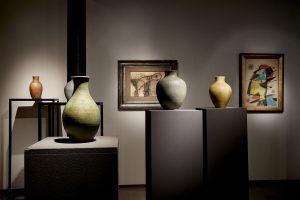"The forms of my works are related to those of the primitive ceramics of all countries and all civilizations (...). My inventive and personal work is in enamels and colours: here I am looking for the new".
Biografia
Josep Llorens i Artigas (Barcelona, 1892 – 1980) is considered one of the most innovative ceramic artist of his generation whose pottery workshop is one of the few Spanish ones which attained international recognition. His work is strongly marked by the influence of the Eastern tradition since he was keenly interested in Chinese and Japanese ceramics. He was inspired by all the ceramics forms of the Song dynasty (960-1279), characterised by its simplicity and elegance.
Llorens Artigas studied at the Escola de la Llotja and afterwards at the Escola d’Art Bells Oficis Francesc Galí, where he first met Joan Miró. He started working as an art critic for the Catalan newspaper La Veu de Catalunya, and wrote about the artists of the Spanish avant-garde: Rafael Barradas, José Frau, Robert Delaunay, Celso Lagar, Joan Miró, Pablo Picasso, and Joaquín Torres García.
In 1921 he travelled to Paris and two years later he settled in Charenton-le-Pont, near the French capital. There, he was interacting with other Spanish artists, especially with Gargallo and Miró, with whom he collaborated afterwards. Various painters valued his work and collaborated with him, such as Raoul Dufy, Georges Braque, Xavier Nogués or Eudald Serra. In 1929, he participated in the Pabellón de los Artistas Reunidos (Artists' Gathering Pavilion) of the Barcelona International Exhibition. During the decade of the 30s, he collaborated with Marquet and presented different individual exhibitions in Paris (1932, 1933). He also continued being present in the Spanish panorama through the Escuela de Altamira, a project to recover the Spanish artistic avant-garde after the Civil War.
Around 1944-45 he started his collaboration with his close friend Joan Miró, a relationship that became more intense at the beginning of the 50s, after Artigas established a pottery workshop in Gallifa, not far from Barcelona, in an 18th-century house in the mountains. There, he created, on the basis of paintings by Miró, the ceramic panels entitled the Wall of the Sun and the Wall of the Moon for the façade of the UNESCO headquarters in Paris (1955), the murals for Harvard University (1960), for the Barcelona airport (1971) and for the Guggenheim Museum (1965–67) in New York.
Towards the end of the 40s, through Eudald Serra, he discovered the mingei movement, the Japanese Folk Crafts Association that aimed at studying and disseminating appreciation and knowledge of mingeihin, the Japanese folk arts and crafts. In 1952, Llorens Artigas met Yanagi Sōetsu, the founder of the movement, and ten years later Hamada Shōji, who become his friend and collaborator. Using Hamada’s kiln in Mashiko as the model, the Catalan artist built a Japanese-style wood-fired climbing kiln (noborigama) in his Gallifa workshop.
Llorens Artigas dedicated himself to working with stoneware, a material used in China even before porcelain. Stoneware is made up of clay, silica, and quartz sands; it is dense, waterproof and opaque in character. The aspect of this form of earth (earth or ground/soil?) can vary, being rougher or smoother, and Llorens Artigas played with all the possibilities it offered. His work draws pure lines, classical and timeless, usually with closed forms. In fact, the artist intention was to eliminate the decorative motifs from his works to achieve the highest quality and beauty in his refined enamel work. He experimented with the glazes and the surprises emerging from the firing.
He always used monochrome glazes, from which other tones appeared due to the chemical reaction of the metallic oxides with the action of the fire. From 1920, he kept records of the firings and formulas of the glazes which he noted next to a sketch of the piece’s silhouette. From 1938 onwards, Artigas often inscribed the sign of the zodiac and its Chinese equivalent in his works.


